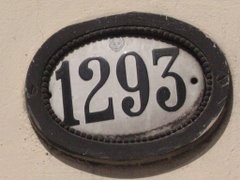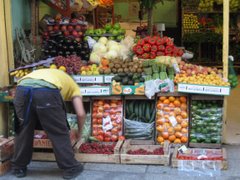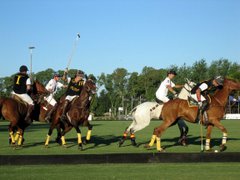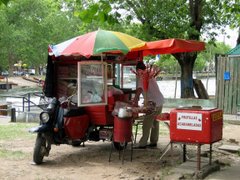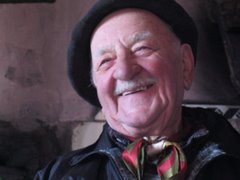Las Cañitas is a peaceful 5 square block neighborhood hidden between the polo fields and a commuter rail which parallels Avenida Dorrego. While tourists swarm Recoleta, Palermo, Puerto Madero and San Telmo, porteños fill the restaurants here almost every night of the week. The parrillas: Las Cholas, El Primo and Campo Bravo are among the most popular in the city. If you can pull it off, book a trip to Buenos Aires in early December and head to Las Cañitas on the 8th for the big polo finals. Call now to book a room in one of three new boutique hotels in the neighborhood (listed below).
Otherwise go any night of the week for dinner at one of the numerous restaurants centered around Baez and Arévalo. Afterwards you can enjoy a drink at Soul Cafe, a super funky cool bar/restaurant was one of the first establishments to open here. Watch for people that look like actors, models, rock stars and athletes. (Whether they actually are or not is beside the point). Or if Soul Cafe is too crowded, try Von Koning which is a shrine to princess Maxima of Holland (an Argentine). Check out the small patio upstairs. Homesick sports fans can catch a game and drink beer at Drink Gallery.
And anytime you have an extra afternoon in town, stop by Las Cañitas for a stroll on Boulevard Chenaut and a little shopping on Arguibel where Etiqueta Negra, Rapsodia and a handful of others brands maintain little known outlets. Complete the visit at one of the lunch spots listed below.
RESTAURANTS
Most popular parillas
Las Cholas (A), Campo Bravo (B), El Primo(B), Liborio(B)
Other parillas also with sidewalk tables
La Fonda del Polo(A), La Lunera(B), La Ochava(B), El Estanciero(B)
Neighborhood family style parillas
El Portugese(O&G), La Bagual(O&G), La Espuela(A)
Argentine/Italian Restaurants
Novecento(B), Arguibel(Argu), Eh! Santino (B), De la Ostia(B), Baez(B), Campo dei Fiori(A), Deniro(B), Las Cortaderas(B), Chenaut 1878(C)
Sushi
Mikado(Arev), Bokoto(H), Sushi Night Cocina Fusion(B), Itamae(Argu), Sushi Club(B)
Pizza
Morelia(B), Romario(O&G), Tonno(A)
Party Crowd
Soul Cafe(B), Kandi(B), Jackie O(B), Beat House(B)
Lunch
El Clasico(B),Piegari Piazza(B), Las Cortaderas(B),Bondesee(O&G)
Bars
Von Koning (B), Blonda (O&G),Drink Gallery (A), Super Soul(B)
SPORTING EVENTS
El Campeonato Argentino Abierto de Polo
Where the best polo in the world is played. Runs from November 17 through the big final on December 8th. La Dolfina, led by Adolfo Cambiasso, won in 2006, 2005 and 2002. Go with friends and mingle with the glamorous crowd. Then walk over to Baez for evening festivities.
Hipodromo de Palermo
Across Libertador is this huge 1.5 mile race track. Go to admire thoroughbreds close up, place a few bets, and enjoy the afternoon sun. Races are held on Monday afternoons and various Fridays, Saturdays and Sundays. January through September. http://www.palermo.com.ar/
BOUTIQUE HOTELS
248 Finisterra(B), Casa Las Cañitas(H) and Tailor Made Hotel(A)
Key: A: Arce, Argu: Arguibel, Arev: Arevalo, B: Baez, C: Chenaut, H: Huergo, O&G: Ortega y Gasset
A blog which may appeal to those who enjoy stories about people, politics, economics, sports, and travel. In and around Argentina and the USA.
9/15/2007
9/09/2007
Date with crisis: Part I The Economy

Is Argentina on the road to redemption or the highway to hell? President Nestor "the Penguin" Kirchner received accolades for his leadership following the 2001 crisis, but a four year period of growth masks severe problems his wife Cristina will inherit as the next head of state. The economy's building blocks are like the ubiquitous hollow bricks of Buenos Aires' frantic construction boom. But Argentina's economic infrastructure is little more than a house of cards.
On Thursday, the government reported an inflation rate of just .6% for the month of August, but some analysts say the real level may be more than twice that (meaning an annual rate of 15%). Official figures have been coming in low since January, when President Kirchner replaced key officials at the national statistics agency INDEC (now disparagingly called INDEK by some). Quoting the Financial Times, "economic growth of more than 8 per cent since the 2002 crisis, booming demand fueled by cheap utilities, and industrial capacity that is stretched to the limit, has proved a triple whammy for prices."
On Thursday, the government reported an inflation rate of just .6% for the month of August, but some analysts say the real level may be more than twice that (meaning an annual rate of 15%). Official figures have been coming in low since January, when President Kirchner replaced key officials at the national statistics agency INDEC (now disparagingly called INDEK by some). Quoting the Financial Times, "economic growth of more than 8 per cent since the 2002 crisis, booming demand fueled by cheap utilities, and industrial capacity that is stretched to the limit, has proved a triple whammy for prices."
Election day is Oct 24th, and Cristina K is the clear front runner against an impotent opposition, but that hasn't stopped hubby from doling out over $1,000,000,000 in classic "happy October" populist handouts in the form of tax rebates, pension and salary increases, and family benefits. The free lunch party may help to maintain economic growth, but is also likely to accelerate inflation. Cristina claims that "political and financial interests" have sought to inflate inflation (numbers). But voters can see exactly how much less their paychecks buy when they set up to checkout counters at supermarkets like Jumbo and Disco. Unfortunately, when it comes time to step up to the ballot box, there won't be any charismatic rival to vote for. The "financial interests" the future president speaks of are the very legitimate holders of inflation-indexed bonds which were introduced when the country restructured its defaulted debt in 2005. If inflation really is 15% the government is underpaying by billions of dollars per year.
Prices are rising rapidly despite government subsidies and price controls achieved by means of strong arm pressure tactics on industry. And price increases are fueling wage demands which are constant. The government has boxed itself into a conundrum that could eventually lead to stagflation - a period of out-of-control inflation combined with very slow, or no, output growth. The president must reduce spending to tame inflation, but that could hurt demand and increase unemployment. (Cristina, who is known to have little interest in economics, has signaled that she will reduce spending and increase the surplus).
In neo-classical economic theory, stagflation "is rooted in the failure of the overall market to allocate goods and services efficiently." And that failure can be caused by excessive government regulation (price controls). In Argentina, changes in monetary policy and deregulation are needed to allow supply and demand to do its thing in a free market. Unfortunately the Kirchner government has shown no capacity to change the way it does business. It's central-planning style has done serious damage to the free market system and chased away much needed investment.
The government's price control bad cop, Guillermo Moreno, is the man in charge of clumsy price negotiation (coercion) efforts. In the case of beef, the government cut off exports in an attempt to force down prices on the local market. Moreno is now in legal hot water for a side project - the infamous new and improved INDEC numbers - and his fate is unknown for now. If a case like his gets to the supreme court, the K's have little to fear since the judges are in their pocket.
President Kirchner feels that he won a big victory for Argentina against the IMF, and that US puppet organization did deserve, and did take, part of the blame for the crisis of 2001. But the government is now trying to borrow $10 billion from the World and Inter-American Development Banks, and a group called the American Task Force Argentina, which represents holders of $20 billion in defaulted debt, is working hard to block the loan. These bond holders sat out a 2005 restructuring in which Argentina paid just 30 cents on the dollar. Argentina also "faces more than 100 lawsuits in the US alone and further legal action in Europe, preventing it from tapping international capital markets for fear of assets issued being seized." The country has been able to avoid that threat thanks in part to investments made by Hugo Chavez.
Cristina is walking into a real mess and when things go from bad to worse it will be impossible for her to blame the prior president. (Hillary is in a better spot in that regard). Cristina will have to take the heat on her own, although Nestor, who may have failed to mention problems x, y or z, will be spending a lot of nights sleeping on the couch.
Argentina has another date with crisis unless major changes are made now.
9/08/2007
Date with crisis: Part II Energy
I doubt President Kirchner has ever won a game of chess. That would require him to see one or two moves ahead. Didn't he know that price controls in the energy sector would lead directly to shortages by fuelling rampant demand and discouraging investment that might have helped increase supply? Couldn't he see that the overheated economic activity in other sectors would spark inflation and thereby sabotage his original simplistic goal, which was low prices for voters? So by forcing down energy prices, he made all the other ones go up. What's really scary is that Cristina Kirchner is known to have much less interest in economics than her husband.
Exxon/Mobil, the world's largest oil company has been doing business in Argentina for over 100 years, but the company is now trying to sell it's assets and exit the country. The simple reason is that the Kirchner government has made it impossible for it to do business here. And after 2 1/2 years of clashes with the government took a turn for the worse last week, Royal Dutch/Shell must be thinking hard about its future here as well.
In the wake of the recent winter energy crisis, Shell was hit with hefty fines and a lawsuit against it's boss for allegedly undersupplying the market. Then last week the government arbitrarily ordered the closing of Shell's Dock Sud oil refinery on trumped up charges of excessive pollution and misuse of water. The refinery has an environmental management system that is ISO 14001 compliant and uses "black" water from the highly polluted Riachuelo river for refrigeration before returning it to the River Plate in a much cleaner condition, a spokesman said. In ordering the closing, inspectors also sited "stains and spills" and improper storage of waste rags.
Why would Kirchner want to shut down an oil refinery in the middle of a touch-and-go energy situation? Is he small-minded enough to carry on a petty school yard grudge without any regard for the consequences? Is Shell simply his scapegoat for the crisis, not to mention a convenient new villain for electioneering? Is Hugo Chavez Nestor's master?
When the first wave of an energy crisis hit this winter the government found itself unable to meet nearly half of all demand for gas on peak days. The first thing the President did was blame the weather. But everyone else in the schoolyard knows that cold days come in winter just as hot ones come in summer. Anyway, Kirchner soon remembered that a big bad corporation makes a better scapegoat than mother nature, and so turned his attention back to a favorite enemy, the Royal Dutch/Shell corporation and it's chief Juan Jose Aranguren.
Thanks to price controls, a megawatt hour of electricity in Argentina sells for $25 compared to $73 in Chile. Consumers continue to pay very little for gas even though the government was forced to increase spending on expensive imports and subsidies. Blackouts this winter did not hit voting customers directly. Factories were forced to shut down from 4pm to 10pm on critical days. Consumers will be protected through the election, but will scream bloody murder if and when prices increase at the pumps and blackouts hit home next year.
More than half of the country's electricity comes from gas and oil fired generators. While more reliable than hydro, wind, or solar. a lack of investment in exploration has left the country with declining gas reserves. A reporter for the Financial Times claims the country has a 7 years supply in proven reserves, but that number sounds highly exaggerated.
The nation is currently building two new gas-powered generators that are scheduled to go on line next year. Argentina also has a hydroelectric project with Paraguay that will be expanded if that country agrees to flood more of its territory (40% of this country's electrical supply comes from hydro). Argentina also has two nuclear power plants, Atucha and Embalse, and construction on a third, which was stopped in 1994, was recently restarted. (Nuclear accounts for the remaining 4% of supply).
One major industry that depends on an efficient energy system is agriculture. But shortages of gasoil, which is used to run machinery, are starting to hit that sector just in time for winter weat harvest. Gas shortages are also threatening the future supply of fertilizers.
So why is Kirchner outwardly hostile to companies like Shell, a major player in the highly competitive energy sector? Foreign investment is essential if Argentina is going to build an efficient system which in necessary to attract investment in other areas of the economy. And without that there will be no GDP growth and therefore jobs, income, health care and education will not improve. Maybe there is one regional foreign power with big plans here. What promises were made to Hugo Chavez in exchange for economic support?
Do Argentines believe that their children will be better off in the future then they themselves are now? The country has waited a long time for a return to prosperity. But Christina Kirchner is not expected to make major changes in economic policy. If elections in October go the way the Kirchners think they will, the wait will go on indefinitely.
Solutions are out there. Someday Argentina will turn to the agriculture sector and the country's vast land resources for one answer to the big energy question: biofuels. But development is in its infancy.
The good news is that high-growth countries like China and India and high-income ones like the United States are in desperate need of resources. When Argentina does finally get serious and build sustainable infrastructure in all areas of society, it right the world will come knocking at its door.
Exxon/Mobil, the world's largest oil company has been doing business in Argentina for over 100 years, but the company is now trying to sell it's assets and exit the country. The simple reason is that the Kirchner government has made it impossible for it to do business here. And after 2 1/2 years of clashes with the government took a turn for the worse last week, Royal Dutch/Shell must be thinking hard about its future here as well.
In the wake of the recent winter energy crisis, Shell was hit with hefty fines and a lawsuit against it's boss for allegedly undersupplying the market. Then last week the government arbitrarily ordered the closing of Shell's Dock Sud oil refinery on trumped up charges of excessive pollution and misuse of water. The refinery has an environmental management system that is ISO 14001 compliant and uses "black" water from the highly polluted Riachuelo river for refrigeration before returning it to the River Plate in a much cleaner condition, a spokesman said. In ordering the closing, inspectors also sited "stains and spills" and improper storage of waste rags.
Why would Kirchner want to shut down an oil refinery in the middle of a touch-and-go energy situation? Is he small-minded enough to carry on a petty school yard grudge without any regard for the consequences? Is Shell simply his scapegoat for the crisis, not to mention a convenient new villain for electioneering? Is Hugo Chavez Nestor's master?
When the first wave of an energy crisis hit this winter the government found itself unable to meet nearly half of all demand for gas on peak days. The first thing the President did was blame the weather. But everyone else in the schoolyard knows that cold days come in winter just as hot ones come in summer. Anyway, Kirchner soon remembered that a big bad corporation makes a better scapegoat than mother nature, and so turned his attention back to a favorite enemy, the Royal Dutch/Shell corporation and it's chief Juan Jose Aranguren.
Thanks to price controls, a megawatt hour of electricity in Argentina sells for $25 compared to $73 in Chile. Consumers continue to pay very little for gas even though the government was forced to increase spending on expensive imports and subsidies. Blackouts this winter did not hit voting customers directly. Factories were forced to shut down from 4pm to 10pm on critical days. Consumers will be protected through the election, but will scream bloody murder if and when prices increase at the pumps and blackouts hit home next year.
More than half of the country's electricity comes from gas and oil fired generators. While more reliable than hydro, wind, or solar. a lack of investment in exploration has left the country with declining gas reserves. A reporter for the Financial Times claims the country has a 7 years supply in proven reserves, but that number sounds highly exaggerated.
The nation is currently building two new gas-powered generators that are scheduled to go on line next year. Argentina also has a hydroelectric project with Paraguay that will be expanded if that country agrees to flood more of its territory (40% of this country's electrical supply comes from hydro). Argentina also has two nuclear power plants, Atucha and Embalse, and construction on a third, which was stopped in 1994, was recently restarted. (Nuclear accounts for the remaining 4% of supply).
One major industry that depends on an efficient energy system is agriculture. But shortages of gasoil, which is used to run machinery, are starting to hit that sector just in time for winter weat harvest. Gas shortages are also threatening the future supply of fertilizers.
So why is Kirchner outwardly hostile to companies like Shell, a major player in the highly competitive energy sector? Foreign investment is essential if Argentina is going to build an efficient system which in necessary to attract investment in other areas of the economy. And without that there will be no GDP growth and therefore jobs, income, health care and education will not improve. Maybe there is one regional foreign power with big plans here. What promises were made to Hugo Chavez in exchange for economic support?
Do Argentines believe that their children will be better off in the future then they themselves are now? The country has waited a long time for a return to prosperity. But Christina Kirchner is not expected to make major changes in economic policy. If elections in October go the way the Kirchners think they will, the wait will go on indefinitely.
Solutions are out there. Someday Argentina will turn to the agriculture sector and the country's vast land resources for one answer to the big energy question: biofuels. But development is in its infancy.
The good news is that high-growth countries like China and India and high-income ones like the United States are in desperate need of resources. When Argentina does finally get serious and build sustainable infrastructure in all areas of society, it right the world will come knocking at its door.
9/06/2007
Interesting people I've see around
Here are some actors, singers and other interesting people I've seen around. Many of these people used to hang around the Roxy in New York City. At that time. The Roxy was known as the Studio 54 of roller discos. It was also a base for the Afrika Bambaataa Zulu Nation scene. The club was famous for breakdancing competitions and was featured in the classic 80s breakdancing film Beat Street.
Ally Sheedy is best known for playing the misfit who gets a makeover from Molly Ringwald in The Breakfast Club. She also acted in St. Elmo's Fire, Bad Boys, WarGames and many others. Ally and I went to the same high school - Columbia Prep. She was two years older than me and close with my friend Peter's older sister Gina. I remember seeing them around in the hallways and I had a crush on both of them. Our high school had only about 200 students - in total - all crammed into one small building on the upper west side. I saw Ally in a school play but I will have to dig up the old year book to tell you what it was. I also met her sister Meghan and once went to their house on Fire Island. I just read that Ally published a best-selling children's book at the age of 12 - didn't know that.
Brenda K Starr is best known for her single "I Still Believe." Mariah Carey sang background vocals for her and Brenda was the one that gave Tommy Mottola Mariah's demo tape at a party. I used to rollerskate with Brenda at The Roxy. My friend Derek got me into this sport and we had a great time in that scene. We skated all night and then met our group of friends for breakfast before heading to Central Park to skate all day near Sheep's Meadow and the Bandshell. Brenda never stopped singing except to laugh and smile and maybe skate around a bit.
Khalil Kain was one of the best skaters at the Roxy and another club called High Roller and was very popular with the ladies. He had a big role in the 1992 film Juice which also starred Tupac Shakur, Omar Epps and Samuel L. Jackson. I remember he did a commercial in which he skated around a store in a bunny suit. My friend Ricki from high school dated him.
Madonna - I saw her perform her first single "Everybody" at the Roxy in 1982. She hung out there as well as Danceteria and other lower-Manhattan nightclubs. After the concert I stood in a small group listening while she chatted with a mutual friend who was her neighbor.
Gene Anthony Ray is best known for the movie Fame. He played the role of Leroy Johnson, the raw street kid who could dance. My friend Derek and I used to see him around the Roxy although I don't remember him being a big skater. Sadly, Ray died of a stoke in 2003.
Paul McCrane also starred in Fame as well as RoboCop and many other movies. He may best known for his role in ER because TV has that global reach. Paul has no connection to the Roxy - I used to see him playing his guitar and singing in Central Park as well as bars on Bleecker Street like the Bitter End. I like his quiet songs from the Fame soundtrack.
Erica Gimpel also starred in Fame, although in this case we're talking about the tv series. (I believe Earl Anthony Ray was the only actor to do both the movie and the tv series). Erica is also recognizable to ER fans and has acted in many other television series. My friends and I used to see her rollerskating at another little spot in Central Park. She was born on the same day as me, so that's nice.
Mason Reese became famous as a cute, red headed kid with a lisp who starred in a television commercial for Underwood Deviled Ham. Later on when my friends and I would talk to him in bars on the Upper West Side he was older, heavier and still very short. A very nice guy.
Grandpa Al Lewis - everyone knows him from The Munsters which ran from 1964 to 1966. I have a picture of him wearing a tuxedo and smoking a cigar a party for the magazine publishing company I worked for in New York, General Media. He died last year and was buried in his favorite cigar box.
Sandra Taylor - best known for her appearances on the Howard Stern show, has also had roles in a number of Gary Marshall movies such as The Princess Diaries, Runaway Bride and Raising Helen. She was also in the Steven Seagal movie Under Siege 2. She is married to my friend Dave O'Connell who also worked at General Media. They have two very cute kids.
Christopher Knight - played Peter on The Brady Bunch. I called on him when he was Vice President of Marketing for a company called IX Micro. He didn't buy any ad space.
Tony Bennett - the American singer famous for his signature song "I Left My Heart in San Francisco" and other favorites such as "I've Got The World On a String." I went to a small event in New York at which he appeared for about 5 minutes and sang just one song. What an amazing voice. I asked him for his signature as he rushed out the door and later glued it to a birthday card for a girlfriend. I wrote something like "happy birthday from two cool guys."
9/05/2007
How Ralph Lauren learned to love polo.
Last December I was in Jose Ignacio, a beach town in Uruguay, with Annie, Merel, Liz and Xan. On New Year's Eve we went to Marismo, a restaurant in the woods that can only be found by following the lights in the trees. The setting is magical with a house like Swiss Family Robinson's and tables spread around camp fires in the sand. Annie recognized our waiter from the year before and soon we had our sandals off, a bottle of champagne on ice, and appetizers on the way. Before midnight I excused myself and went to look for the men's room. I was in there for about a minute when I noticed that someone, having skipped the usual knock at the door, was busy trying to force it open. So I said one moment please and went over to the sink to wash up. When I opened up I saw immediately that it was Ralph Lauren - a man who mustn't be kept waiting.
When you hear the word "polo" what comes to mind first? For the majority of Americans it may be Ralph Lauren's colognes rather than the equestrian sport. When thinking of pony polo, most citizens of the United States may have in their minds only a vague idea of horses and mallets and the Prince of Wales. In places other than East Hampton and Palm Beach, Lauren's logo itself - the little polo player getting ready to hit a ball - is probably the most familiar image of the sport. The sport of polo may not have a lot of reach, but I was surprised to learn that in 40 years in business, Ralph Lauren has never had any connection to it. In recent years his corporation has sponsored the US Open and Wimbledon as well as a number of pro golfers, but as far as the game on horseback, Lauren has not only not had any involvement, the company has repeatedly sued the United States Polo Association over alleged trademark violations.
The New York Times reported today that all that has finally changed. The Polo Ralph Lauren Corporation now sponsors the East Hampton/Palm Beach team, Black Watch, and has designed new jerseys for the squad which you can buy at ralphlauren.com. Happily, it seems, the company has put aside years of unseemly feuding with the sport: polo has at long last gotten together with polo.
So where did this change of heart come from? And where did Ralph and company find inspiration for the new Black Watch shirt? Does part of the answer lie in a trip Ralph and his entourage took to Argentina last December and a chance encounter at a restaurant in Jose Ignacio?
Ralph Lauren was born Ralph Lifschitz in the Bronx New York in 1939. At age 16, Ralph's brother Jerry changed their last name. Ralph was 17 when he started working for Alexanders Department store as a part-time sales assistant and later also worked for Bloomingdale's and Brooks Brothers. In the early sixties he served in the US Army. In the mid-sixties he worked as traveling salesman for a Boston neck wear manufacturer. In 1967 he was a designer for the Polo Neckwear Division of Beau Brummel. A year later, with the help of a backer, he bought the name and launched Polo Fashions. By 1969 he was operating a boutique within Bloomingdale's in New York and in 1971 he opened his first retail store on Rodeo Drive. Lauren later did the costuming for The Great Gatsby(1973) and Annie Hall (1977), two films that had a great influence on fashion in that era. The Polo Ralph Lauren Corporation now has 14,000 employees and a market cap of nearly $8 billion.
The famous short sleeve shirt with the polo player logo first appeared in 1972 and a line of copy from the original ad read, "Every team has its color - Polo has 24." For the new Black Watch team shirt Ralph Lauren wisely chose just black and white. The company states on its web site that it is "is pleased to be the official sponsor of Black Watch and will provide match and practice apparel—polos, caps, fleece pullovers and additional accessories—for the team as well as for its managers and grooms." Black Watch, by the way,"borrows its name from the renowned Black Watch Scottish fighting regiment that served the British crown for 266 years." The new shirts are made of "lustrous mercerized cotton mesh" and come embroidered with the team's high profile player Ignacio Figueras' number 2.
Figueras is a 29 year old player from Argentina. He is also, not coincidentally, a model for Ralph Lauren. Figueras is currently visible in airports as the face of Polo Black cologne. A professional polo player since the age of 17, Nacho started working for Ralph Lauren when he met Bruce Weber 7 years ago. Weber paired him in a campaign with Penelope Cruz.
Figueras must have also served as an advisor for the Lauren's trip to Argentina and Uruguay in late December 2006 and early January 2007. The Lauren entourage visited their own store, in a beautiful townhouse on Alvear Avenue, and spent time at an estancia where they probably watched a polo match. They then traveled to Uruguay to kick off the new year in Jose Ignacio. They chose Marismo for their New Year's Eve celebration and that takes us back to our story.
When I got back to our table I reported my encounter with Ralph Lauren, and everyone thought I must have got it wrong. Maybe too much champagne, they said. I assured them that it had been him. But then it was time to welcome the new year and we got up to dance barefoot in the sand around one of the big fires. A couple joined us and confirmed that yes, Ralph Lauren was in town, and yes that was him sitting over there with his party, hard to miss actually since all 20 of them were dressed from head to toe in white. We looked and we could see that they were watching us dance.
Soon Liz decided that she would go over to say hello and try to get us in for photos, but she needed an ice breaker. Xan and I had recently bought slick black and white polo jerseys in Buenos Aires and he was wearing his that night. So I said just ask Ralph what he thinks of the shirt. Liz walked over to their table and introduced herself to Ralph and sure enough could soon be seen pointing back at us. We took the cue and before long all of us were standing around chatting with Ralph and company. We met his wife Ricky, his brother Jerry and the Lauren's cute little dog. Jerry was quite enthusiastic about the polo shirt which was designed by Etiqueta Negra (Black Label) for the Argentine team Ellerstina. We joked that Xan had number 1 and I had number 2. They told us about their trip and we took some pictures. After that we excused ourselves and headed back to our table feeling a little star struck. Here is Xan with Ralph and Xan again with Ralph's brother Jerry Lauren.


Did the Laurens learn to love polo on that trip? And was the Etiqueta Negra jersey Xan wore that night the inspiration for Ralph Lauren's new Black Watch shirts? As far as the later question, I'll let you be the judge. Here are pictures from Etiqueta Negra and Ralph Lauren.


When you hear the word "polo" what comes to mind first? For the majority of Americans it may be Ralph Lauren's colognes rather than the equestrian sport. When thinking of pony polo, most citizens of the United States may have in their minds only a vague idea of horses and mallets and the Prince of Wales. In places other than East Hampton and Palm Beach, Lauren's logo itself - the little polo player getting ready to hit a ball - is probably the most familiar image of the sport. The sport of polo may not have a lot of reach, but I was surprised to learn that in 40 years in business, Ralph Lauren has never had any connection to it. In recent years his corporation has sponsored the US Open and Wimbledon as well as a number of pro golfers, but as far as the game on horseback, Lauren has not only not had any involvement, the company has repeatedly sued the United States Polo Association over alleged trademark violations.
The New York Times reported today that all that has finally changed. The Polo Ralph Lauren Corporation now sponsors the East Hampton/Palm Beach team, Black Watch, and has designed new jerseys for the squad which you can buy at ralphlauren.com. Happily, it seems, the company has put aside years of unseemly feuding with the sport: polo has at long last gotten together with polo.
So where did this change of heart come from? And where did Ralph and company find inspiration for the new Black Watch shirt? Does part of the answer lie in a trip Ralph and his entourage took to Argentina last December and a chance encounter at a restaurant in Jose Ignacio?
Ralph Lauren was born Ralph Lifschitz in the Bronx New York in 1939. At age 16, Ralph's brother Jerry changed their last name. Ralph was 17 when he started working for Alexanders Department store as a part-time sales assistant and later also worked for Bloomingdale's and Brooks Brothers. In the early sixties he served in the US Army. In the mid-sixties he worked as traveling salesman for a Boston neck wear manufacturer. In 1967 he was a designer for the Polo Neckwear Division of Beau Brummel. A year later, with the help of a backer, he bought the name and launched Polo Fashions. By 1969 he was operating a boutique within Bloomingdale's in New York and in 1971 he opened his first retail store on Rodeo Drive. Lauren later did the costuming for The Great Gatsby(1973) and Annie Hall (1977), two films that had a great influence on fashion in that era. The Polo Ralph Lauren Corporation now has 14,000 employees and a market cap of nearly $8 billion.
The famous short sleeve shirt with the polo player logo first appeared in 1972 and a line of copy from the original ad read, "Every team has its color - Polo has 24." For the new Black Watch team shirt Ralph Lauren wisely chose just black and white. The company states on its web site that it is "is pleased to be the official sponsor of Black Watch and will provide match and practice apparel—polos, caps, fleece pullovers and additional accessories—for the team as well as for its managers and grooms." Black Watch, by the way,"borrows its name from the renowned Black Watch Scottish fighting regiment that served the British crown for 266 years." The new shirts are made of "lustrous mercerized cotton mesh" and come embroidered with the team's high profile player Ignacio Figueras' number 2.
Figueras is a 29 year old player from Argentina. He is also, not coincidentally, a model for Ralph Lauren. Figueras is currently visible in airports as the face of Polo Black cologne. A professional polo player since the age of 17, Nacho started working for Ralph Lauren when he met Bruce Weber 7 years ago. Weber paired him in a campaign with Penelope Cruz.
Figueras must have also served as an advisor for the Lauren's trip to Argentina and Uruguay in late December 2006 and early January 2007. The Lauren entourage visited their own store, in a beautiful townhouse on Alvear Avenue, and spent time at an estancia where they probably watched a polo match. They then traveled to Uruguay to kick off the new year in Jose Ignacio. They chose Marismo for their New Year's Eve celebration and that takes us back to our story.
When I got back to our table I reported my encounter with Ralph Lauren, and everyone thought I must have got it wrong. Maybe too much champagne, they said. I assured them that it had been him. But then it was time to welcome the new year and we got up to dance barefoot in the sand around one of the big fires. A couple joined us and confirmed that yes, Ralph Lauren was in town, and yes that was him sitting over there with his party, hard to miss actually since all 20 of them were dressed from head to toe in white. We looked and we could see that they were watching us dance.
Soon Liz decided that she would go over to say hello and try to get us in for photos, but she needed an ice breaker. Xan and I had recently bought slick black and white polo jerseys in Buenos Aires and he was wearing his that night. So I said just ask Ralph what he thinks of the shirt. Liz walked over to their table and introduced herself to Ralph and sure enough could soon be seen pointing back at us. We took the cue and before long all of us were standing around chatting with Ralph and company. We met his wife Ricky, his brother Jerry and the Lauren's cute little dog. Jerry was quite enthusiastic about the polo shirt which was designed by Etiqueta Negra (Black Label) for the Argentine team Ellerstina. We joked that Xan had number 1 and I had number 2. They told us about their trip and we took some pictures. After that we excused ourselves and headed back to our table feeling a little star struck. Here is Xan with Ralph and Xan again with Ralph's brother Jerry Lauren.


Did the Laurens learn to love polo on that trip? And was the Etiqueta Negra jersey Xan wore that night the inspiration for Ralph Lauren's new Black Watch shirts? As far as the later question, I'll let you be the judge. Here are pictures from Etiqueta Negra and Ralph Lauren.


A coincidence? Maybe, maybe not. I have more fun believing that yes, everything gelled on that trip. The best polo in the world is played in Argentina: the best ponies and players are also from here. On their trip, the Laurens may have been watching a match when they realized how nicely everything fit together. The company had had Figueras under contract for 7 years, but his profile had recently skyrocketed. And he played for a polo team with a cool name. A sponsorship would be a relatively low cost, low risk move with potential benefits on the marketing side. They were certainly aware of the success Argentine companies like La Martina have had marketing polo apparel. A new Ralph Lauren team polo could carve out a niche in the US as an upscale alternative to the ususal baseball shirt.
And then, in a restaurant in the woods, they stumbled on the perfect look for their new shirt.
So how is the team doing now after all that? Unfortunately, last month, Black Watch/Ralph Lauren lost in the finals of the Mercedes Benz Challenge Cup to Two Trees/La Dolfina. But La Dolfina features Adolfo Cambiaso, the best player in the world. On the business side I see that Polo Ralph Lauren stock is down about 25% since early July. Like many competitors the company has been hurt by consolidation in the department store industry. To combat this Lauren has been investing in a new "Global Brand Concepts" business.
Whoever's in charge of that business had better make something happen in a hurry because, Ralph, the son of a house painter from the Bronx, doesn't like to be kept waiting.
9/04/2007
Subscribe to:
Posts (Atom)




































































